Fleets Must Understand Fuel-Efficiency Testing Options, NACFE Report Says

Fleets face a multitude of fuel-efficiency testing methods, each with unique contexts and applications, making comparisons challenging and confusing, and extrapolation to the real world even more so, the North American Council for Freight Efficiency said in its latest report.
The document, issued in January, is intended to provide an overview of the fuel and freight efficiency measurement and estimation methods so that fleets have the information they need to make better investment decisions, no matter the technology, NACFE said.
The report uses aerodynamic technologies as the example case through which to explore the various testing methods.
It addresses five methods: computer model-based testing, specifically, computational fluid dynamics analysis; wind tunnel testing; track testing, including coastdown testing; on-road testing; and fleet composite evaluation testing.
Also discussed is the impact of more than a dozen real-world conditions on testing, including ambient temperature, road surfaces and vehicle maintenance level.
Whether comparing the fuel efficiency of two transmissions, two engines, two tractors, two trailers or even two drivers, the comparison will involve some form of test data from one or more of those sources, the report said.
But multiple challenges make the process difficult for fleets.
The report breaks down the challenges of sorting through performance testing data into six categories. It noted that all of them overlap: variance among testing methods, extrapolation of test results, need to precisely attribute efficiency gains, use of older data and confusion between the terms precision and accuracy.


